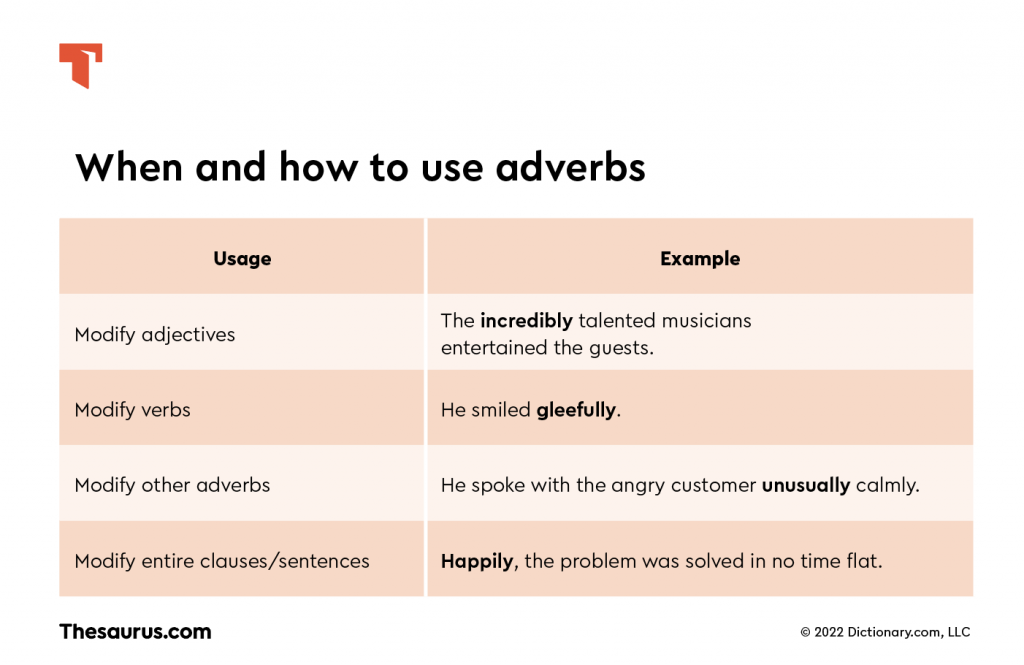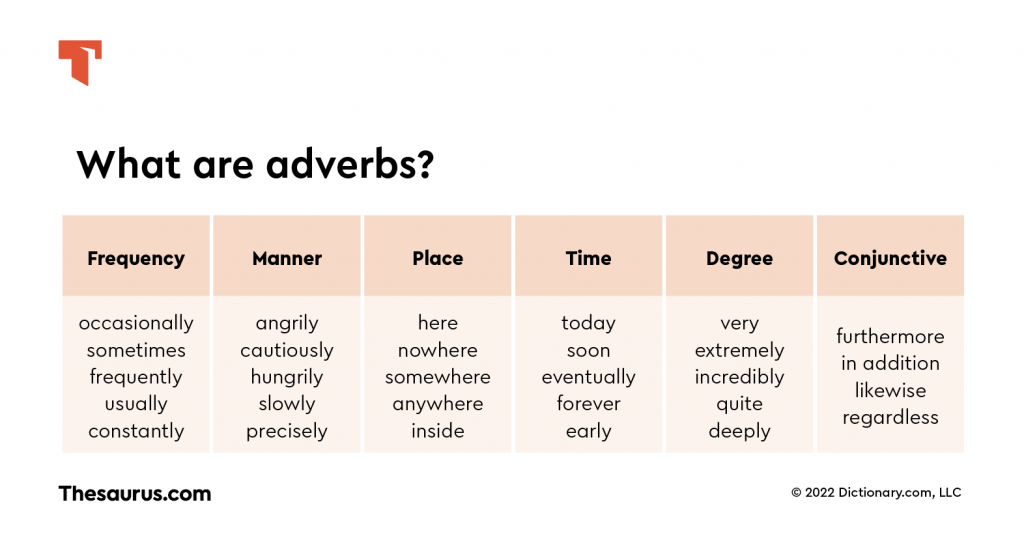Adverbs are a major part of speech that we use to both provide more information and jazz up our sentences. For example, the sentence Jenna walked is a fine sentence but a little unexciting. However, we can spice things up with an adverb, as in the sentence Jenna walked gracefully. If Jenna is a little clumsy, we could alternatively say Jenna walked awkwardly. If we want to add a little suspense, we can say Jenna walked suspiciously. Finally, we can travel under the sea by saying Jenna walked underwater. (Aren’t adverbs amazing?)
In all of our example sentences, we used adverbs to modify a verb. However, adverbs can do so much more than that! Before we get ahead of ourselves, though, it is best if we start by figuring out what an adverb is.

What is an adverb?
An adverb is a word that is used to modify verbs, adjectives, clauses, and other adverbs. Many adverbs end in -ly, and they usually appear next to the word that they modify. In the sentence Bob carefully built a sandcastle, the word carefully is an adverb that modifies the verb built.
Adverbs are a commonly used part of speech that, like adjectives, provide more information in a sentence or clause by modifying (describing) another word. Adverbs are used to answer questions such as How?, Where?, When?, How often?, and How much? For example, in the sentence Jessie will clean her room tomorrow, the adverb tomorrow tells us when Jessie plans to clean her room. As another example, the word incredibly is used in the sentence Darius is incredibly tired to say that Darius isn’t just a little tired but he is tired to the point that he could fall asleep any moment.
Unlike adjectives (and most other parts of speech), adverbs can sometimes be moved to another spot in a sentence, and the sentence will still make grammatical sense. Typically, this is possible when an adverb is modifying a verb. For example,
- The dog slept peacefully on her bed.
- The dog peacefully slept on her bed.
- The dog slept on her bed peacefully.
All three of the above sentences are grammatically correct and have the same meaning even though the adverb peacefully changes positions. When writing or saying longer sentences, though, it is often a good idea to keep the adverbs close to the verbs they modify to improve a sentence’s clarity:
- We quickly ran through the spooky woods to the safety of the peaceful meadow.
- We ran through the spooky woods to the safety of the peaceful meadow quickly.
While the second sentence does make sense, it is harder to tell which word the adverb quickly is supposed to be modifying. By keeping the adverb close to the verb it modifies, the sentence is easier to read and understand.
When adverbs are used to modify adjectives or other adverbs, they are usually placed immediately before the word they modify:
- Adjective: He was really hungry.
- Another adverb: The spider crawled up the wall very slowly.
When an adverb modifies an entire sentence or clause, we usually put it before the sentence/clause it modifies and follow it with a comma:
- Luckily, the groom made it to the wedding just in time.
How else can you use a comma? With a conjunction, for one. Find out the rules here.
Adverb examples
There are many adverbs that we use in our sentences. As you are about to see, many of them end in -ly. The following list gives some examples of adverbs:
- amazingly, beautifully, carefully, darkly, eagerly, fast, greatly, hesitantly, inside, jokingly, later, musically, now, on, patiently, quietly, restlessly, sideways, tomorrow, underwater, very, willingly, yesterday, zealously
What is an adverb clause?
While adverbs are single words, it is also possible for an entire clause to function as an adverb. We refer to this as an adverb clause. As is the case with most other dependent clauses, adverb clauses usually begin with conjunctions such as before, because, if, and whenever. Although they are entire clauses, adverb clauses are used the same way that regular adverbs are: to modify verbs, adjectives, or other adverbs. For example, in the sentence We need to leave before the mall closes the adverb clause before the mall closes modifies the verb leave.
Adverb clause examples
We can use adverb clauses in several different ways:
- Modify a verb: We ran across the street. (Modifies ran)
- Modify an adjective: School will be closed if it snows tomorrow. (Modifies closed)
- Modify an adverb: They worked faster than they ever had before. (Modifies faster)
Like adverbs, it is sometimes possible to move an adverb clause around and have a sentence still make sense. For example,
- Even though it probably wouldn’t work, we tried the plan anyway.
- We tried the plan anyway, even though it probably wouldn’t work.
How are adverbs used?
Adverbs have a lot of different uses. We can use them to modify verbs, adjectives, other adverbs, or entire sentences. Adverbs often tell us how, when, where, why, how often, or to what degree that something happens.
Modify adjectives
Adverbs can modify adjectives. When they do, they usually appear right next to the word they modify.
- The flowers are really pretty.
- The incredibly talented musicians entertained the guests.
- I was very busy yesterday.
Modify verbs
Adverbs can modify verbs. When they modify verbs, adverbs may not always appear right next to the verb that they modify.
- He smiled gleefully.
- The cats went outside.
- I could listen to this song forever.
When it comes to verbs, you need to be very careful about a particular type of verb known as a linking verb. Linking verbs are often used to link a noun or pronoun with a subject complement. Adverbs are NOT used to modify nouns or pronouns, and they are NOT used as subject complements. If you see a linking verb used in a sentence, think twice about using an adverb.
Take a look at the following sentence:
- The house looks bad.
In this sentence, looks is a linking verb. It is being used to describe the quality of the house by linking the adjective bad to the noun house.
Now, look at this sentence:
- The house looks badly.
In this sentence, the adverb badly can only modify the word looks because house is a noun, and adverbs do not modify nouns. This sentence says that the house is bad at looking at things, which doesn’t make any sense. As you can see, it is important to be able to identify linking verbs so you don’t accidentally use an adverb when you need an adjective.
Modify other adverbs
It is even possible for adverbs to modify other adverbs. As was the case with adjectives, adverbs usually stick right next to the word that they modify when used to describe another adverb.
- Please speak very slowly.
- We crossed the rickety bridge really carefully.
- He spoke with the angry customer unusually calmly.
Modify entire clauses/sentences
When a single adverb is modifying an entire sentence/clause, it is typically placed before whatever it is modifying and followed by a comma:
- Happily, the problem was solved in no time flat.
- Oddly, the birds circled overhead without landing.
- Suddenly, an army of robots burst into the room.
Compare two or more items
Like comparative and superlative adjectives, we can also use adverbs to compare multiple things to each other. It is best to review the rules of comparative and superlative adjectives before using adverbs in comparisons. In short, when we compare two people/things, we typically use a word ending in -er or the word more or less. When we compare more than three people/things, we typically use a word ending in -est or the word most or least.
- We finished our homework quicker than we did yesterday.
- Jeff did well on the exam, but Sarah did better.
- He who laughs last will laugh loudest.
- Out of every competitor, Aaron danced most gracefully.
Types of adverbs
Adverbs can do a lot of different jobs. When we refer to different types of adverbs, we are usually talking about what they are being used to describe. For example:
- Frequency: occasionally, sometimes, frequently, usually, constantly
- Manner: quickly, accidentally, cooperatively, sadly
- Place: here, everywhere, nowhere, above, inside, outdoors
- Time: yesterday, never, tomorrow, now, yet
Feel free to visit this review of the types of adverbs today, tomorrow, and frequently.
Adverb vs. adjective: what’s the difference?
Adverbs are used similarly to another part of speech known as adjectives. Both adjectives and adverbs are used as modifiers in sentences. They give more information when used with other words.
The main difference between adjectives and adverbs is what words they modify. Adjectives only modify nouns and pronouns. As mentioned previously, adverbs can modify verbs, adjectives, entire sentences and clauses, and even other adverbs.
The key to determining whether to use an adjective or an adverb as a modifier is to figure out what part of speech is being modified. If you want to modify a noun or a pronoun, you need an adjective. If you want to modify something else, you need an adverb. Adverbs do NOT modify nouns or pronouns.
For example, take a look at the following sentence:
- I cuddled the cat.
This sentence is fine but a little plain. Suppose you wanted to make this sentence more interesting by describing the cat. Before you do, consider what kind of word cat is. It is a noun. Because it is a noun, you need to use an adjective to modify it as in:
- I cuddled the fluffy cat.
Let’s go back to our original sentence again. This time, we want to give more information about how we treated the cat. So, we want to modify the word cuddled. Before we go grab a modifier, let’s consider what kind of word cuddled is. It is a past tense verb. Because it is not a noun or a pronoun, we will use an adverb to modify it as in:
- I gently cuddled the cat.
By identifying the word you want to modify, you can avoid making a grammatical error and mixing up adjectives and adverbs. Let’s test this out by looking at the following sentence and choosing the correct word:
- My dog smelled (bad/badly) after she rolled around in the stinky garbage.
Before we can choose the right word, we need to consider what we are trying to say. We want to say that the dog had a stinky smell after playing in the trash. So, we know that the word smelled is a linking verb in the sentence and not an action verb: the dog isn’t smelling something. The word that we want to modify, then, is the word dog because we want to describe the dog’s odor. We know that the word dog is a noun. Since we are modifying a noun, we would use the adjective bad and not the adverb badly.
Can you identify the adverbs in a sentence? Take this quiz to find out.
Quickly! Read all about GrammarCoach™
Run quickly, don’t walk, to check out Thesaurus.com’s Grammar Coach™ and find out what it can do for you (and your adverbs). This tool examines your writing using machine learning technology uniquely designed to catch grammar and spelling errors. Its Synonym Swap will find the best nouns, adjectives, and more to help say what you really mean, guiding you toward clearer, stronger, writing.
Grammar Coach™ is here to help you with any writing assignment or project you have!
















